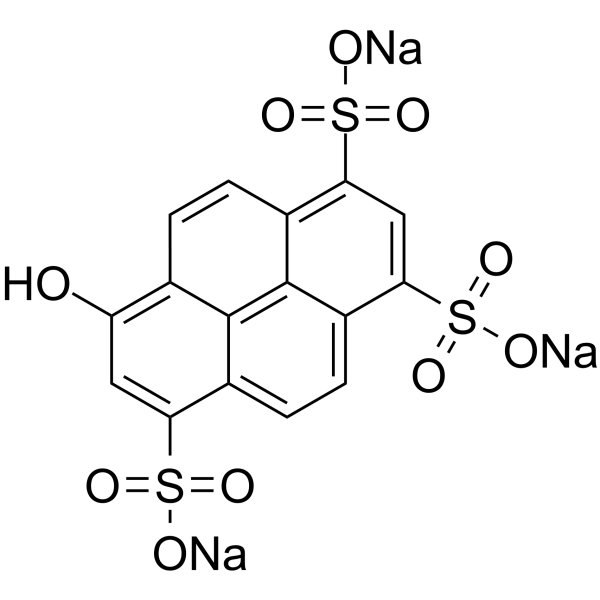Pyranine;(Synonyms: 溶剂绿7; HPTS; Solvent Green 7) 纯度: ge;98.0%
Pyranine (HPTS; Solvent Green 7) 是一种 pH 敏感的荧光指示剂。Pyranine 是一类用于 Cu+ 离子的荧光化学传感器 (λex=450 nm,λem=510 nm)。

Pyranine Chemical Structure
CAS No. : 6358-69-6
| 规格 | 价格 | 是否有货 | 数量 |
|---|---|---|---|
| Free Sample (0.1-0.5 mg) | ; | Apply now | ; |
| 10;mM;*;1 mL in DMSO | ¥550 | In-stock | |
| 500 mg | ¥500 | In-stock | |
| 1 g | ¥800 | In-stock | |
| 5 g | ; | 询价 | ; |
| 10 g | ; | 询价 | ; |
* Please select Quantity before adding items.
Pyranine 相关产品
bull;相关化合物库:
- Bioactive Compound Library Plus
| 生物活性 |
Pyranine (HPTS; Solvent Green 7) is a pH-sensitive fluorescent indicator. Pyranine acts as a class of fluorescent chemosensor for the Cu+ ion(λex=450 nm, λem=510 nm)[1][2][3]. |
||||||||||||||||
|---|---|---|---|---|---|---|---|---|---|---|---|---|---|---|---|---|---|
| 体外研究 (In Vitro) |
Pyranine is capable of discriminating ranges of cations from the Cu+ ion, even in competing environment. Pyranine displays a rapid fluorescence response (t1/2=1.66 min) towards the Cu+ ion, and the micromolar detection limit enables the detection of the ion in environmental samples. The observed stoichiometry of complexation between Pyranine and Cu+ is 2:1[1]. MCE has not independently confirmed the accuracy of these methods. They are for reference only. |
||||||||||||||||
| 分子量 |
524.39 |
||||||||||||||||
| Formula |
C16H7Na3O10S3 |
||||||||||||||||
| CAS 号 |
6358-69-6 |
||||||||||||||||
| 中文名称 |
溶剂绿7 |
||||||||||||||||
| 运输条件 |
Room temperature in continental US; may vary elsewhere. |
||||||||||||||||
| 储存方式 |
4deg;C, sealed storage, away from moisture and light *In solvent : -80deg;C, 6 months; -20deg;C, 1 month (sealed storage, away from moisture and light) |
||||||||||||||||
| 溶解性数据 |
In Vitro:;
H2O : 100 mg/mL (190.70 mM; Need ultrasonic) DMSO : 25 mg/mL (47.67 mM; Need ultrasonic) 配制储备液
*
请根据产品在不同溶剂中的溶解度选择合适的溶剂配制储备液;一旦配成溶液,请分装保存,避免反复冻融造成的产品失效。 |
||||||||||||||||
| 参考文献 |
|
| Cell Assay [3] |
PAAm-κC composite gels are prepared by free-radical copolymerization using 0.71 g of AAm, 0.01 g of BIS (N, N’-methylenebisacrylamide), 0.008 g of APS (ammonium persulfate) and 2 µl of TEMED (tetramethylethylenediamine) are dissolved in 5 mL of distilled water (pH 6.5) by heating. The heated mixture solution is held at 80°C. Then different amounts of κ-carrageenan (0.5, 1, 1.5, 2, 2.5 and 3 (w/v) % κC) are added. Pyranine (Py) is used in the PAAm–κC composites as a fluorescence probe, which is a derivative of pyrene possessing three SO3– groups, which can form bonds with positive charges on the gel. Pyranine (Py) concentration is kept constant at 4×10-4 M, for all experiments. The solution is stirred (200 rpm) for 15 min to achieve a homogenous sample solution. All samples are deoxygenated by bubbling nitrogen for 10 min just before the polymerization process. The drying and swelling experiments of disc-shaped PAAm–κC composite gels prepared are performed in air and in water, respectively, at various temperatures (30, 40, 50, and 60°C). A model LS-50 spectrometer equipped with a temperature controller is used for fluorescence intensity measurements, which are made at a 90° position and spectral bandwidths are kept at 5 nm. Disc-shaped gel samples are placed on the wall of a 1-cm path-length square quartz cell filled with air and/or water for the drying and swelling experiments[3]. MCE has not independently confirmed the accuracy of these methods. They are for reference only. |
|---|---|
| 参考文献 |
|
